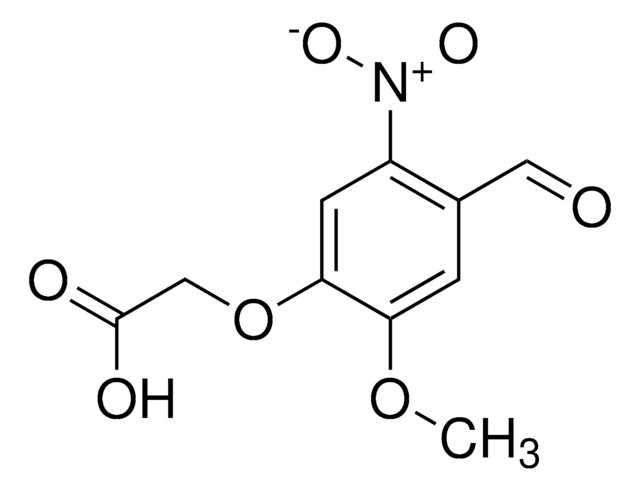55262
4-[4-(1-Hydroxyethyl)-2-methoxy-5-nitrophenoxy]butyric acid
≥98.0% (HPLC), for peptide synthesis
Synonyme(s) :
Hydroxyethyl photolinker
About This Item
Produits recommandés
product name
4-[4-(1-Hydroxyethyl)-2-methoxy-5-nitrophenoxy]butyric acid, ≥98.0% (HPLC)
Pureté
≥98.0% (HPLC)
Forme
powder
Pertinence de la réaction
reagent type: cross-linking reagent
Pf
163-166 °C
Chaîne SMILES
COc1cc(C(C)O)c(cc1OCCCC(O)=O)[N+]([O-])=O
InChI
1S/C13H17NO7/c1-8(15)9-6-11(20-2)12(7-10(9)14(18)19)21-5-3-4-13(16)17/h6-8,15H,3-5H2,1-2H3,(H,16,17)
Clé InChI
DUIJUTBRRZCWRD-UHFFFAOYSA-N
Autres remarques
Code de la classe de stockage
11 - Combustible Solids
Classe de danger pour l'eau (WGK)
WGK 3
Point d'éclair (°F)
Not applicable
Point d'éclair (°C)
Not applicable
Équipement de protection individuelle
dust mask type N95 (US), Eyeshields, Gloves
Certificats d'analyse (COA)
Recherchez un Certificats d'analyse (COA) en saisissant le numéro de lot du produit. Les numéros de lot figurent sur l'étiquette du produit après les mots "Lot" ou "Batch".
Déjà en possession de ce produit ?
Retrouvez la documentation relative aux produits que vous avez récemment achetés dans la Bibliothèque de documents.
Notre équipe de scientifiques dispose d'une expérience dans tous les secteurs de la recherche, notamment en sciences de la vie, science des matériaux, synthèse chimique, chromatographie, analyse et dans de nombreux autres domaines..
Contacter notre Service technique








